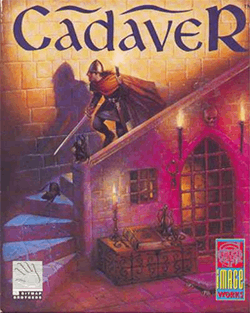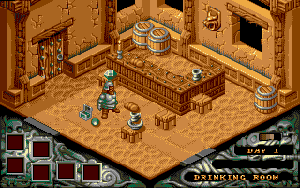Cadaver (video game)
| Cadaver | |
|---|---|
 Cover art | |
| Developer(s) | Bitmap Brothers |
| Publisher(s) | Image Works |
| Producer(s) | Graeme Boxall |
| Designer(s) |
Mike Montgomery Steve Kelly Eric Matthews Phil Wilcock |
| Programmer(s) |
Mike Montgomery Sean Griffiths |
| Artist(s) |
Daniel Malone Robin Chapman |
| Composer(s) | Richard Joseph |
| Platform(s) | Amiga, Atari ST, MS-DOS, Acorn Archimedes |
| Release | August 1990 |
| Genre(s) | Action-adventure |
| Mode(s) | Single-player |
Cadaver is an isometric action-adventure game by the Bitmap Brothers, originally released by Image Works in August 1990, for Atari ST, Amiga, MS-DOS and Acorn Archimedes. In the game the player controls Karadoc the dwarf.
Plot and levels

In the original Cadaver, Karadoc, who is a gold-hungry dwarf and really just hopes to find a treasure, is on a mission to seek out and kill the necromancer Dianos, the sole remaining inhabitant of Castle Wulf.
The game consists of five levels representing different floors of Castle Wulf. Entering the castle via the sewers, Karadoc works his way up from the dungeons, through guard chambers, royal hall, the king's private chambers and finally the battlements with Dianos's sanctum.
Karadoc's main modus operandi is picking up, throwing, pulling, pushing and stacking objects. By piling up a number of boxes, bones or other items, it is possible to reach higher places. Karadoc can find and use a small number of weapons such as rocks and shuriken, but puzzles are the main driving-force behind the gameplay.
The game is heavily scripted. The isometric objects can react to a variety of other objects; for instance, a poisoned key can be cleaned by dropping a vial of water on it, and potions can be enhanced by the potion booster spell. The game has a wide variety of puzzles requiring items to be found, brought and used in a variety of places. The solutions to these puzzles sometimes require leaps in logic and the game has plenty of secret areas, hidden spells etc. Many of the puzzles also have multiple-solutions and there is often no specific order that the puzzles on a level have to be solved in.
Gameplay
Movement
The game is played using a joystick, with which you can control the movement of Karadoc in 8 directions. The directions are not as one would expect in a game from today - instead, they are rotated. If you push the joystick up, Karadoc will run "north", which is right-up on the screen. If you want Karadoc to move up on the screen (which is "north-west" in the game), you need to push the joystick left-up. The fire button of the joystick is used to jump.
Interaction with objects
When Karadoc touches an object, he can push it around, unless it is too heavy (a potion of strength allows pushing heavier objects). Touching an object also causes the context menu to be enabled. When the context menu is enabled, the fire button is used to select an action from the menu instead of jumping. The possible actions depend on the type of object, and are represented with icons. They include things like investigate, pull, pick up, drink, open, insert, give and some others. Items which are picked up land in Karadocs inventory, and get additional actions, like cast for spells. One item at a time also can be readied, usually a weapon, which makes the fire button throw or use the readied item instead of jumping.
Expansion pack
An expansion pack titled Cadaver: The Payoff was released in 1991. After defeating Dianos, Karadoc returns to the inn only to find his employers gone, and every living person within the city either dead or transformed into a monster. Seeking the cause behind this, the dwarf fights his way to the local temple, and finds the answers - and his money - deep down in the crypts.
Gameplay is similar. Cadaver: The Payoff has only four levels, but they are significantly larger than those of the first game, and the second level has a large number of monsters and scant possibilities to heal.
Demos

There are three levels besides the nine from the two official releases:
- Gatehouse, an early preview demo of the game, released on Amiga Format Cover Disk #13.[1]
- Temple.[2]
- The Last Supper, a demo released on Zero Coverdisk #15 in issue 23.[3] The story takes place in the "Zeigenhoff" building, and sometimes this demo is referred to by that name.
Reception
The game was received very well at its release. According to the official site, it has received the following awards:
- Golden Chalice 1990 Adventure Game of the Year
- Generation 4 1990 Best Foreign Adventure
- Golden Chalice Adventure Game of the Year
The Atari version was awarded as "C+VG HIT" in the Computer and Video Games magazine issue 107 [4] in 1990. In the same year, the Amiga version received a "CU Screen Star" from the CU Amiga Magazine [5] and was made an "Amiga Joker Hit" in the Amiga Joker magazine ,[6] amongst others
References
- ↑ Pages 87,88; Amiga Format issue 13 (August 1990),
- ↑ pages 16,17; Zero issue 16 (February 1991) & Coverdisk 8 of same
- ↑ Pages 8,9; Zero issue 23(September 1991) and Coverdisc 1 of same
- ↑ Swan, Robert; "Cadver"; Review in "C+VG magazine issue 107 (October 1990)"
- ↑ Patterson,Mark;"Cadver"; review in CU Amiga November 1990,pp40-41
- ↑ Max Magenauer, Amiga Joker 12/90